If you’ve had an interest in niche sites and SEO for even a short while, you’ve likely heard of “longtail” keywords.
Unfortunately, there’s still confusion out there about what they are. Some people even ignore these highly valuable sources of search traffic, site visitors with buying intent (meaning more earnings!), and better content.
In this post, we’ll cover the basics, explain it all clearly, and show you why they’re so valuable.
What are longtail keywords?

To help explain what they are, let’s use a few examples and talk more about how they’re related to search volume.
The exponential graph chart shown here represents the typical search volume vs the number of keywords of certain types you’ll find when doing keyword research. As a matter of fact, in the green area above, up to around 70% or so of the keywords for a related topic may be longtails.
For example:
- A very short single keyword like “shoes” tends to be extremely high volume, but there are usually a fairly small number of those keywords you’ll find when using your favorite SEO tool.
- Mid-range keywords (in terms of search volume) tend to be 2-3 words or so in length and turn up a slightly larger number of keyword results.
- At the tail end of the graph you see, there are a high number of low-volume keywords that will show up. These tend to be very specific keyword phrases made up of several words.
Hence the name longtail keywords. These are very specific, “specialty” terms people with especially particular needs will use when searching for information or buying advice.
Some good examples would be:
- “best running shoes for people with ankle pain”
- “best hiking shoes for people with flat feet”
- “which are the best shoes for women with bad arches”
…and so on. This is obviously very different than the case of higher competition terms like “best shoes” which are often ranking with e-commerce or niche sites with very high authority.
Note: While longtail keywords are longer in their word count versus others, this is generally the case. There are cases where it’s not true – never assume that longtail keywords must be longer in length. That’s a common misconception some make.
Longtail keyword statistics
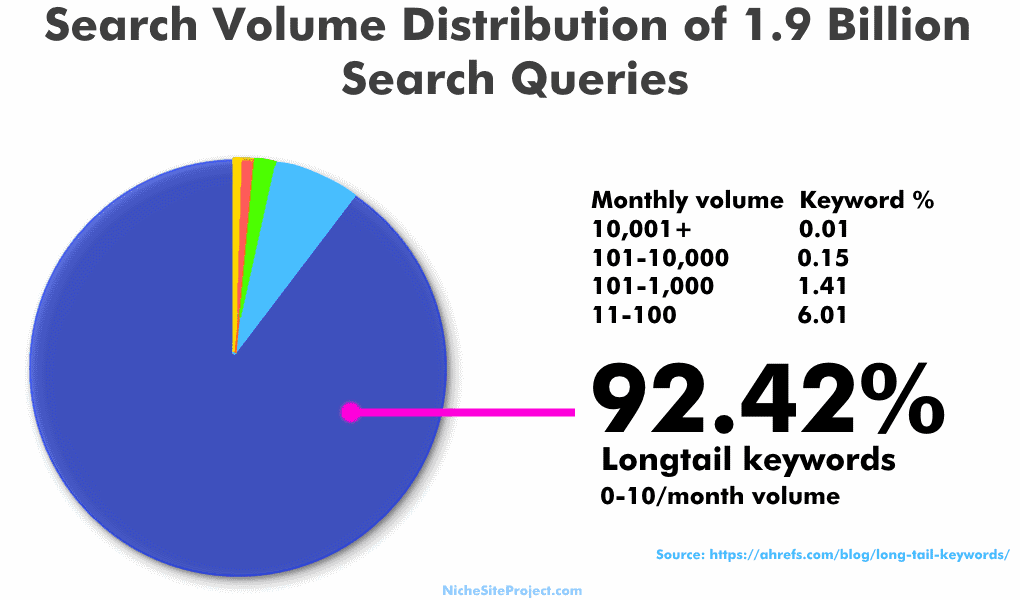
What’s fascinating is that given what I just described, you might think that longtail keywords would be only a small portion of the total keywords out there for a given search topic – but they’re not. In fact, longtail keywords make up the majority of search terms out there!
According to AHRef’s United States database, keywords with a monthly search volume of ten or below make up an incredible 92.42% of their keyword data. That’s from a sample size of 1.9 billion keywords!
But if these keywords are in a much lower tier in terms of search volume, why do we care? As it turns out, there are some excellent reasons!
Why they’re so valuable and how they can benefit you
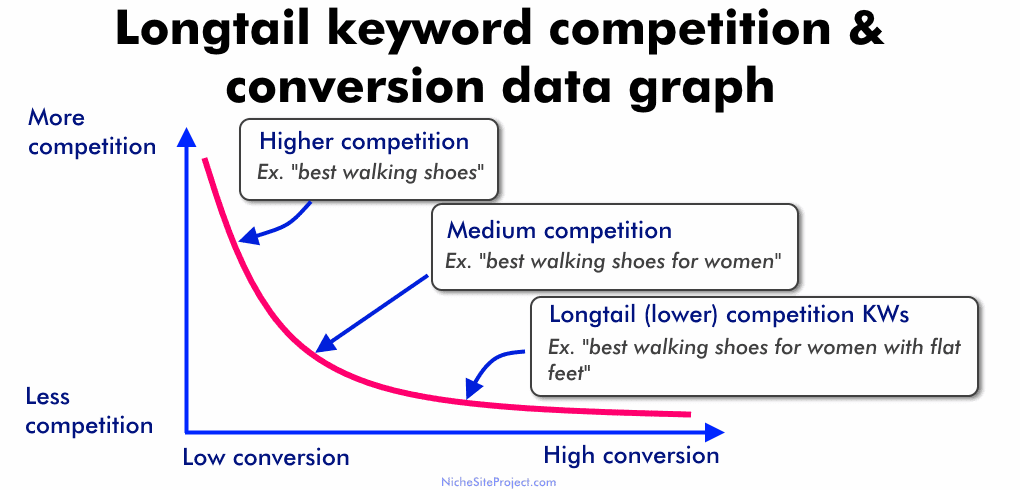
As you can see in this graph, shorter, more general keyword (KW) terms have a much higher search volume and a higher competition level too. Likewise, longtail keywords, while lower volume in search, have much less competition. That’s because many affiliate sites ignore them.
Longtail keywords have tremendous value to us for several reasons. Here’s why:
- Longtail keywords have significantly less competition than higher-competition or medium competition keywords. This is excellent as you’ll have far fewer niche sites you’ll have to compete against; especially those sites with a much higher domain authority (DA) and backlink profile than yours.
- There are far more longtail keywords to sort through and find good candidates for ranking in the top 10 (especially when using Keyword Golden Ratio method).
- Better buyer intent: For buyer intent keywords, as shown in the graph above, since the search intent is very specific and often problem/solution-oriented, there’s very good buyer intent. This means that while volume may be low, the search traffic you get tends to be more serious about clicking & buying.
- Lower competition: Longtail keywords are often ignored by high-strength & older sites which makes them an excellent potential for ranking in the top 10 in many cases. That means far less time & effort to rank soon, rather than fighting a long-term battle just to get in the 1st page search results. (How can you improve your keyword search results is a guide to help)
- Good candidates for secondary keywords: For keywords you don’t feel are worth an entire post (or aren’t worth trying to rank for), they still have good value! Many longtail keywords can boost traffic when used as secondary keywords in H2s in your related content.
The importance of longtail keywords
Despite being low volume, they also tend to be very good for conversions (clicking and then buying) meaning that they’re still great choices for your site. But why exactly is this?
As it turns out, it’s mostly about search intent. When people use search queries for very specific topics, they’re more serious and their buying intent tends to be higher.
This is in contrast to people who use more vague search queries (such as only “walking shoes”) and are only curious about a topic, rather than being ready to solve their particular problem and spend money.
Ultimately, longtail keywords are important because they can attract search traffic from buyers with higher buying intent.
Example: Someone searching for “best walking shoes” may or may not be ready to buy. However, a person with the search query “best walking shoes for women with flat feet” in the example above tends to be looking for a solution to their special problem and therefore is often serious about buying. Hence, longtail keywords targeting buyers (“Best”, “vs” , “review”, and etc) have good potential for additional niche site earnings.
Additionally, if you’re a beginner and struggling with building initial site traffic, since they’re low competition they’re an excellent way to grow your site and move forward. This especially true in competitive niches!
Why fight an uphill battle and go after heavily-competitive, difficult keywords you might not rank well for any time soon? Take my recommendation and go after these instead.
How to find longtail keywords
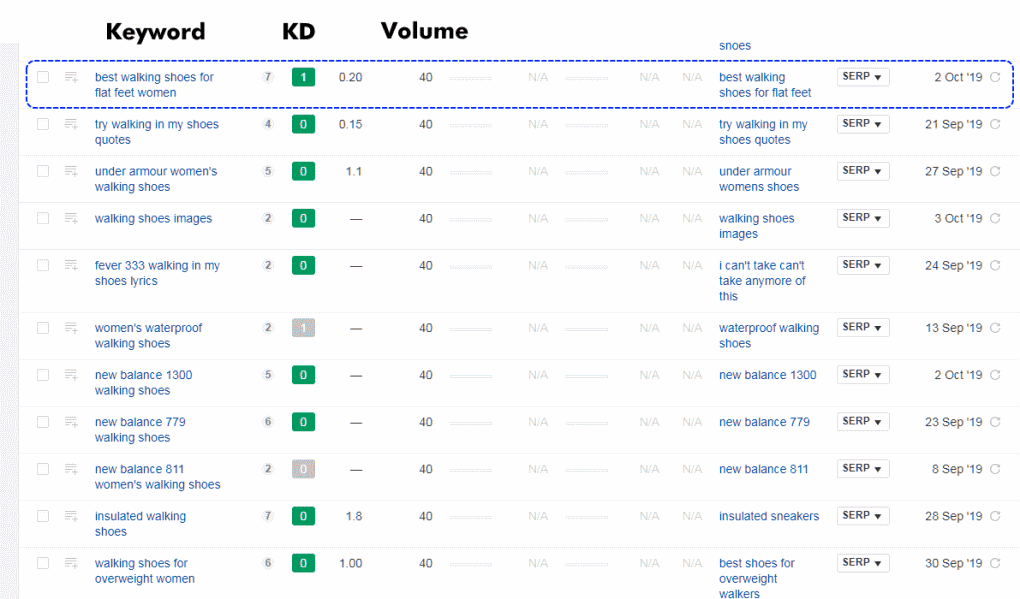
Shown: Search results with a longtail keyword shown. Note that while it’s not in the 0-10 range, the search volume is still low and we’ll find there’s weaker competition than high-volume keywords.
Finding longtail keywords isn’t difficult, which makes using them an even better option than ever. But where and how do we find them?
There are a variety of methods, but we’ll cover some of the main ones here:
- Using your favorite keyword tool, when using a seed keyword (such as “walking shoes” in this example), filter heavily by search volume and if available. keyword difficulty (KD) too. For example, I filter by 0-40 and below to get a good result but 0-10 nearly guarantees you’ll get a good variety.
- Google autocomplete results: Ever noticed that when typing a phrase into the Google search bar that it presents some related keywords automatically? These are often a great source of longtail keywords too. These can be manually recorded and checked or even scraped (saved using automatic software) if you like.
- Hobby/interest groups, forums, and more: Forums, Reddit sections, and more are often a source of harder-to-find longtail keywords. In this case, you’ll need to visit these hobbyist/interest groups & forums yourself and see what keywords (search queries) show up. In my experience, some surprisingly unique and low-competition ideas can be found. While it’s a slow process, the upside is that you’re able to reveal some niches & keyword ideas that aren’t being targeted much, or at all.
- Answer The Public: A site like AnswerThePublic.com is a great resource for generating topics & related keywords based on a parent topic. For example, by entering “walking shoes” from the example above we can generate a very long list of many longtail keywords – first by exporting them as a standard comma-separated value (CSV) spreadsheet and then evaluating for hidden gems, both for informational posts & buyer intent posts.
- Searches related to..: At the bottom of your search engine results page (SERPs) you’ll find a list of related keywords that Google is specifically telling you people also look for. They’re another great source, too!
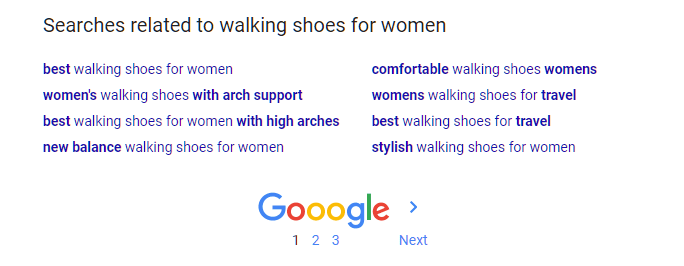
Google related searches info, sometimes a good source for additional longtail keyword ideas – or ideas for your next topic, too!

An example of using the Google autocomplete feature to find excellent longtail keywords. Here, we’re using the “best walking shoes for women” as the seed keyword. You can find some great opportunities this way, just like Doug recommends in his video here!
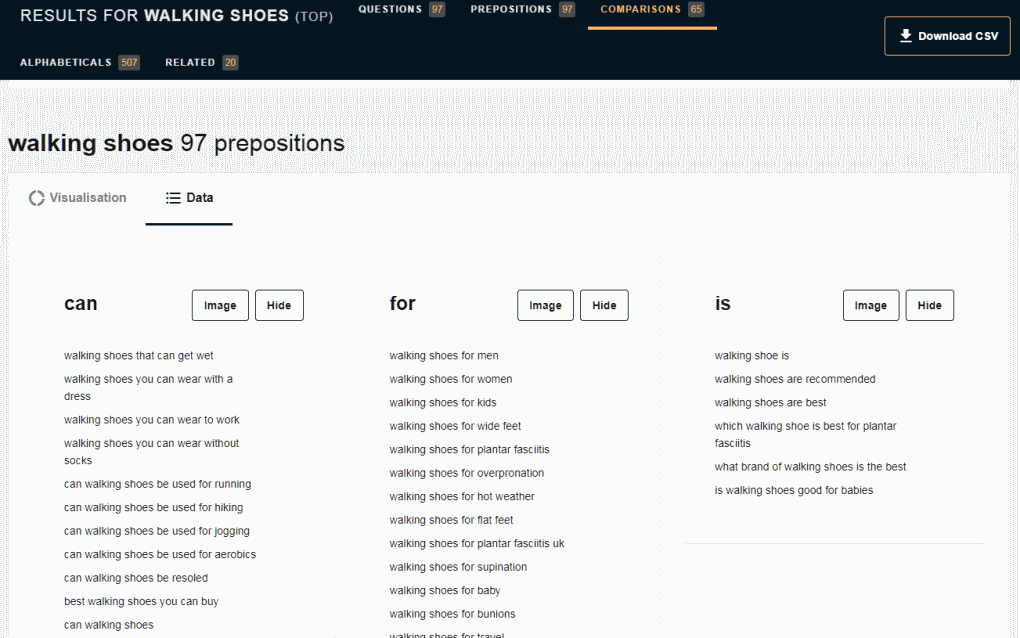
Example of using a resource like Answer The Public to generate related longtail keywords, both buyer intent & informational. You can use a seed keyword phrase like “walking shoes” to get a long list of results to export and evaluate for great keyword opportunities
Tips for keyword tool longtail research
Generally speaking, it depends on how your particular keyword research tool handles the data you get. However, as a general rule, the simplest way to find longtail keywords with a keyword tool is:
- Don’t filter on the low end. That is, don’t set the minimum search volume to anything above zero.
- If a keyword difficulty filter is available, use it. For example, in AHRefs, I can easily set the KD to a maximum of 1 or even 0 to ensure the results will nearly always give me a “clean” list of almost all longtail keywords. Some lower-cost tools now offer a similar feature that can do the same.
- Filter by a maximum search volume of 40 or below. Again, your particular tool will vary in behavior. From my own experience, I’ve found that many of my best longtail keywords were around 40/month search volume and under. While you can use 10/month and below as a filter, my advice is to allow a bit of leeway as the 0-10 search volume range isn’t a “hard and fast” rule. Try and see what you find, then adjust as needed.
- Don’t ignore supposed “zero” search volume keywords. As Evan Porter explained in this post, sometimes keyword tools report a zero search volume when in fact you’ll get good traffic if you still go after them. In my experience, it’s true! Also, when SEO tool data is too new or insufficient, the tool may report zero when in fact there is already some search traffic present.
Evaluating what we’ve got: How to decide if a longtail keyword is good
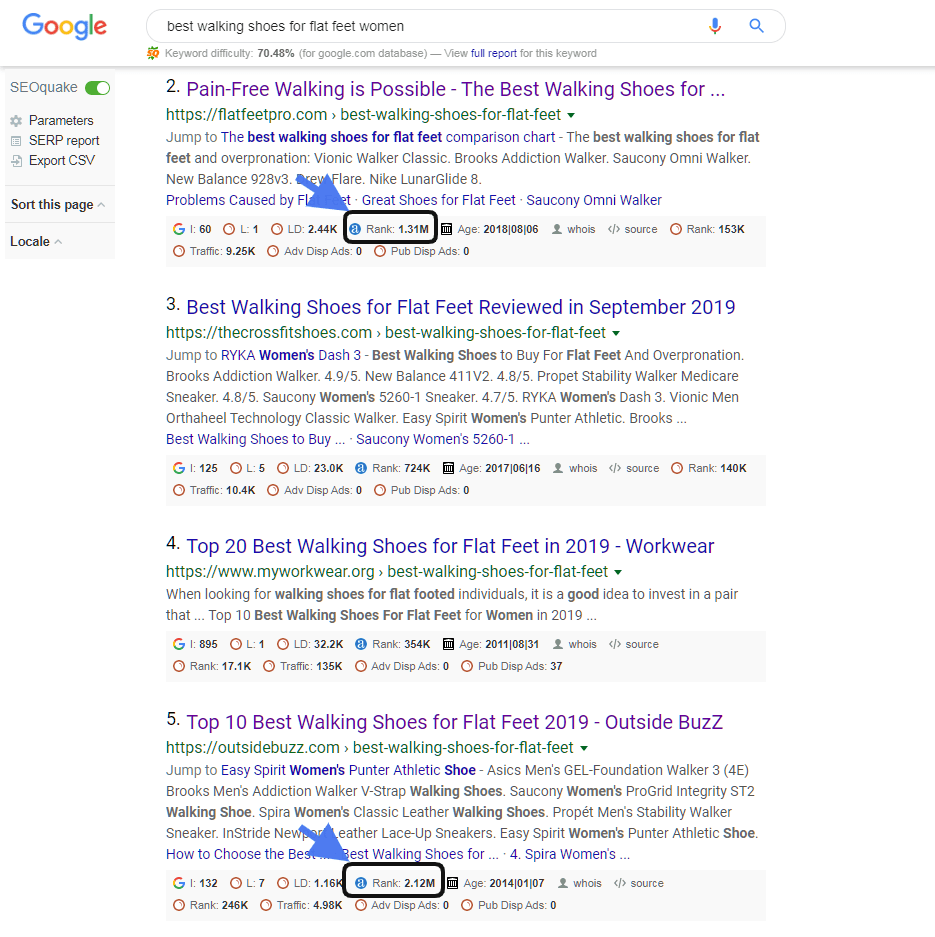
When evaluating a keyword (in this case, a longtail keyword like the one in the search bar as shown) it’s critical to check the competition & how Google treats it in search results. Otherwise, you can fail before you even start!
Once we’ve put together a list of potential longtail keywords in a nice spreadsheet (you are keeping things organized, right?) we can begin evaluating which ones we can rank for in the top 10. Then we can start planning to write our content.
The good news is there are just a few basic steps to follow:
- Narrow down the keywords worth we may go after. Ideally, even with a list as long as 300 keywords like I have from time to time, the most efficient way is to quickly narrow them down. I use Doug’s Keyword Gold Ratio (KGR) rule to help me greatly reduce the number of keywords I should evaluate before writing content. Once you’ve done that, you can move forward with checking these potential keywords individually. (As the KGR process is a different topic so I’ll leave that as another subject)
- Check how Google is treating the longtail keyword. More specifically, it’s super important to make sure that Google doesn’t interpret a longtail keyword as part of a more general search topic. For example, if we’re evaluating “best walking shoes for women with flat feet” and Google returns a lot of results such as “best walking shoes“, we’ll have to compete with more competitive sites. In that case, it’s often best to move on to a keyword with less competitive, and more specific, search results & search intent.
- If a keyword passes test #1, we’ll check our competition. This is actually quite an easy step depending on your approach. My way is to use the SEOQuake Chrome browser extension to see the statistics & strength of my competitors in the top 10 rankings. I can easily see if I have a good chance or not of ranking. (This isn’t a guarantee to rank, but it works as high as 70% of the time!)
- Mark the longtail keywords that pass as potential content topics and move forward with creating posts for those.
In the image above, you’ll see the Alexa ranking provided for websites appearing in the top 10 results in Google. When the Alexa ranking is in the millions, that’s a sign it’s a weaker website – especially true for Amazon affiliate sites in my experience. The Alexa ranking goes from a lower number (much stronger site, often in the thousands or hundreds of thousands) to a higher number (in the millions) to represent a weaker site.
If at least one website appearing in search results has a weaker rating (high Alexa number) I know I stand a good chance ranking for that keyword if I produce good content and follow good SEO rules of thumb.
The downside of using longtail keywords
As you might have guessed by now, when using longtail keywords, there is, of course, a “con” to using them. As they’re lower in terms of search volume, the downside is that you’ll need to produce more posts in order to drive a lot of overall traffic to your site.
That’s in opposition to going after a more competitive keyword like those with search volumes in the thousands per month. While it would be great to get fantastic traffic for just one keyword, in the real world it’s really hard and when competing with very established sites it takes a significant investment in time, effort, and backlinks to rank anywhere close to the top sites.
Overall, it’s a far easier approach to simply put out more content based on longtail keywords that are much easier to rank for.
If you’re worried about low search volume, there’s good news! We can actually get much better results by optimizing the content we create for our longtail search keywords (main keywords).
Getting the most out of longtail keywords
As I mentioned earlier, there are more benefits than just traffic. One of my favorite – and most effective – is to use longtail keywords as secondary keywords to drive more traffic and create better content.
The benefits of using longtail keywords in blog posts
Want more traffic? Why not use the longtail keywords from our list that we’ve decided we can’t rank for in our content to drive additional traffic?
In other words, we can optimize our content for better SEO by using additional (secondary) keywords and not just the main keyword. To do so is pretty straightforward, in fact!
- Find keywords relevant to the topic and which will fit into place as H2 and H3 subtopics.
- Collect several (3-4 is pretty typical for me) and use them to value to your content by expanding on each as subtopic with a few paragraphs.
- Pick longtail keywords highly relevant to the main keyword and helpful to the reader.
For example, let’s say our main keyword is the longtail “best walking shoes for women with flat feet.” Our keyword list could potentially contain some highly relevant keywords (especially informational), that we can pick out and use for subtopics.
Some typical examples might be those such as:
- how to deal with flat feet pain
- what kinds of material do the best walking shoes have?
- how to choose insoles for walking shoes
…and so on. As I explain more in my post here, you’ll drive even more traffic as well as create a longer, higher-quality post your readers will appreciate.
Hi Doug,
Thank you for this excellent info!
Is the volume 40 means 40 people searches in the entire US per month for that keyword? Wouldn’t that be very low to write an article?
Nick, thanks for for question. But it is not as you think. Search volume is not equal to the potential trafffic you’re about to get. The metrics is based on the average mothly searches in past months or years. When you go for lower search volume (with longtail keyword which usually have long phrase) you will rank for many related and similar keywords appearing in your main keyword.
Hence, the traffic you’will get is from different similar keywords. Say a longphrase keyword with as low as volume of 40/month can drive the traffic of upto 400/month or more.
So don’t be hesitate to target the great lower volume longtail keywords in your article with a focused main keywords. If you use similar longtail keywords as subtopic (h2, h3… headings) then you’re post can rank for tons of keywords over the period of time which can generate the traffic of even thousands.
I recomend you to read this ahrefs report: https://ahrefs.com/blog/keyword-traffic-estimation and I hope this will clear your doubt.
Yes, Uddeshya!! You got it. Thank you for answering this for me.
Thank you very much, your blog is a goldmine with content you couldn’t find in paid courses =)
Very well-written Doug! I absolutely love the explanation with the graph – as you go more to the right, the less search volume, easier to rank for and better buying intent. It literally changed the view on how I look at the keywords right now 🙂 Thanks for this content!
Thanks Doug,
Checking out your YT channel now, to stay focused and discipline.
Thanks again